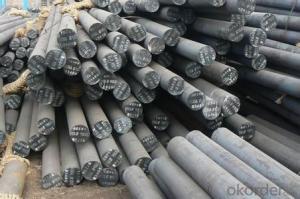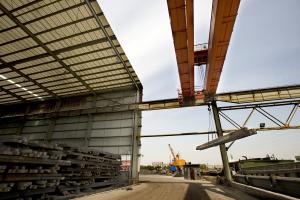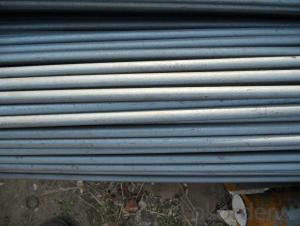C45 1045 Carbon Steel Round Bar for Machinery and Hardware Fields
- Loading Port:
- Tianjin
- Payment Terms:
- TT OR LC
- Min Order Qty:
- 100 m.t.
- Supply Capability:
- 500000 m.t./month
OKorder Service Pledge
OKorder Financial Service
You Might Also Like
Specification
C45 1045 Carbon Steel Round Bar for Machinery and Hardware Fields
Product Description of C45 1045 Carbon Steel Round Bar for Machinery and Hardware Fields
1. Steel grade: ASTM4140, SCM440, 42CrMo, DIN1.7225
2. Length: 6M-12M
3. Diameter: 16mm-300mm
4. Product range: round bar, flat bar, square bar
5. Technique: Hot rolled, forged, cold drawn
Specification of C45 1045 Carbon Steel Round Bar for Machinery and Hardware Fields
Material | SCM4140 | Round bar | Dia(mm) | 16-300mm |
Process | EAF + LF + VD + Forged + Heat Treatment (optional) | Length (mm) | Max 12m | |
Heat treatment | Normalized / Annealed / Quenched / tempered | Flat bar | Thickness(mm) | 8-500mm |
Delivery condition | Hot forged +Rough machined (black surface after Q/T)+ Turned (optional) | Width(mm) | 70-200mm | |
Test | Ultrasonic test according to SEP 1921-84 D/d | Length (mm) | Max 12m |
Chemical Composition of C45 1045 Carbon Steel Round Bar for Machinery and Hardware Fields
C | Si | Mn | Cr | Mo | P | S |
0.38~0.43 | 0.15~0.35 | 0.75~1.00 | 0.8~1.1 | 0.15~0.25 | ≤0.035 | <0.04< td=""> |
Photo Show of C45 1045 Carbon Steel Round Bar for Machinery and Hardware Fields

Packing and Delivery:
Packing in bundle package, or as customer's requirements.
Delivery Detail: 45 days after receiving the deposit.
Usage and Applications of C45 1045 Carbon Steel Round Bar for Machinery and Hardware Fields
1. Steel round bar is used in a large number of architectural and engineering structures. Or it can be used in construction of plants for the production of steel house frames, high-voltage transmission towers, bridges, vehicles, boilers, containers, ships, etc.
2. And we can use this kind of product on the performance of the mechanical parts if the demand is not very high.
3. Some special material steel round bar can be used for main shaft of steamer, hummer shank, with big section and supper force.
Company Information
CNBM International Corporation is the most important trading platform of CNBM group.
Whith its advantages, CNBM International are mainly concentrate on Cement, Glass, Iron and Steel, Ceramics industries and devotes herself for supplying high qulity series of refractories as well as technical consultancies and logistics solutions.


F A Q
1, Your advantages?
professional products inquiry, products knowledge train (for agents), smooth goods delivery, excellent customer solution proposale
2, Test & Certificate?
SGS test is available, customer inspection before shipping is welcome, third party inspection is no problem
3, Factory or Trading Company?
CNBM is a trading company but we have so many protocol factories and CNBM works as a trading department of these factories. Also CNBM is the holding company of many factories.
4, Payment Terms?
30% TT as deposit and 70% before delivery.
Irrevocable L/C at sight.
5, Trading Terms?
EXW, FOB, CIF, FFR, CNF
6, After-sale Service?
CNBM provides the services and support you need for every step of our cooperation. We're the business partner you can trust.
For any problem, please kindly contact us at any your convenient time.
We'll reply you in our first priority within 24 hours.
- Q: Are steel round bars recyclable?
- Yes, steel round bars are recyclable. Steel is one of the most commonly recycled materials in the world, and round bars made of steel can be easily melted down and reused to make new steel products.
- Q: Can steel round bars be customized or fabricated?
- Yes, steel round bars can be customized or fabricated to meet specific requirements. Steel round bars are commonly used in various industries such as construction, manufacturing, and engineering. They can be customized in terms of diameter, length, surface finish, and even material composition. Customization of steel round bars can be done through various processes. For example, the bars can be cut to the desired length using techniques like sawing or shearing. They can also be bent or shaped using heat and mechanical force to achieve specific angles or curves. Additionally, the surface finish of the bars can be altered through processes like grinding, polishing, or coating. Furthermore, steel round bars can be fabricated to include additional features or components. For instance, holes or slots can be drilled or machined into the bars to accommodate other parts or fasteners. They can also be threaded or grooved to allow for easy assembly or connection with other components. In summary, steel round bars can be customized or fabricated in various ways to suit specific needs. Whether it is altering the dimensions, shape, surface finish, or adding additional features, steel round bars offer flexibility and versatility in meeting different requirements across industries.
- Q: Can steel round bars be used in the medical industry?
- Yes, steel round bars can be used in the medical industry. Stainless steel round bars, in particular, are commonly used in medical applications due to their corrosion resistance, strength, and durability. These bars can be used in the production of various medical devices and equipment, including surgical instruments, orthopedic implants, dental tools, and prosthetics. The high-quality stainless steel ensures that these products can withstand the demanding conditions of medical environments and provide optimal performance and safety to patients. Additionally, stainless steel round bars can be easily sterilized, making them suitable for use in sterile medical settings.
- Q: Can steel round bars be used in the manufacturing of couplings?
- Yes, steel round bars can be used in the manufacturing of couplings. Steel round bars are commonly used in various industrial applications due to their strength, durability, and versatility. Couplings are mechanical devices that connect two shafts together in order to transmit power or allow for the misalignment of the shafts. Steel round bars can be machined, formed, or welded to create different types of couplings, such as rigid couplings, flexible couplings, or universal couplings. The use of steel round bars in manufacturing couplings ensures that the couplings have high tensile strength and can withstand heavy loads and torque. Additionally, steel round bars can be heat-treated to enhance their mechanical properties, making them suitable for different operating conditions and environments. Therefore, steel round bars are a popular choice for the manufacturing of couplings.
- Q: How do steel round bars perform under torsion or twisting forces?
- The exceptional performance of steel round bars in resisting torsion or twisting forces is widely recognized. Thanks to their inherent strength and stiffness, steel round bars can endure high levels of torque without experiencing significant deformation or failure. When subjected to torsion, steel round bars display what is known as elastic behavior. Initially, the bar will twist and deform elastically, meaning it will revert to its original shape once the twisting forces are no longer applied. This elastic deformation is directly proportional to the magnitude of the applied torque, in accordance with Hooke's law. However, if the torsional forces surpass the elastic limit of the steel round bar, it will undergo plastic deformation. This entails the permanent twisting of the bar, preventing it from returning to its original shape after the forces are released. The extent of plastic deformation depends on the magnitude and duration of the torsional forces. The high tensile strength of steel round bars makes them highly resistant to torsional failure, enabling them to withstand substantial twisting forces. Moreover, the round bars' smooth and uniform surface reduces the likelihood of stress concentrations, further enhancing their torsional performance. It is crucial to note that the torsional performance of steel round bars can be influenced by various factors, such as alloy composition, heat treatment, and manufacturing processes. By carefully selecting appropriate steel grades and employing suitable processing techniques, the torsional strength and performance of steel round bars can be further optimized to meet specific application requirements.
- Q: What are the different surface finishes available for steel round bars?
- There are several different surface finishes available for steel round bars, including hot rolled, cold drawn, polished, turned, and ground.
- Q: Can steel round bars be hardened and tempered?
- Yes, steel round bars can be hardened and tempered. This process involves heating the steel to a specific temperature, followed by rapid cooling to increase its hardness. Subsequently, the steel is reheated to a lower temperature and slowly cooled to improve its toughness and durability.
- Q: What are the different grades of steel used for round bars?
- Round bars are commonly made from different grades of steel, each with its own composition and properties. These grades are suitable for various applications. Some widely used grades for round bars include: 1. Mild Steel (Low Carbon Steel): This is the most commonly used and basic grade of steel. It has a low carbon content, making it inexpensive and easy to work with. Mild steel round bars find applications in construction, automotive, and general engineering. 2. Carbon Steel: With higher carbon levels than mild steel, carbon steel offers improved strength and hardness. Round bars made from carbon steel are often used in high-stress applications like structural components, axles, and shafts. 3. Alloy Steel: By adding elements like chromium, nickel, or molybdenum to the base steel, alloy steel round bars enhance strength, toughness, and resistance to corrosion. They are commonly used in aerospace, automotive, and machinery industries. 4. Stainless Steel: Known for its corrosion resistance due to high chromium content, stainless steel round bars offer excellent strength, durability, and resistance to rust and staining. They are widely utilized in the food industry, marine applications, and architectural components. 5. Tool Steel: Designed specifically for high hardness, wear resistance, and heat resistance, tool steel round bars are commonly used in the manufacturing of cutting tools, dies, and molds. These examples demonstrate the variety of steel grades suitable for round bars. Each grade possesses unique properties, making them ideal for diverse applications across different industries.
- Q: What are the different types of steel round bar finishes for decorative purposes?
- There are several different types of steel round bar finishes that are commonly used for decorative purposes. These finishes can enhance the aesthetic appeal and overall look of the steel round bar, making it suitable for various decorative applications. Some of the most popular finishes include: 1. Polished Finish: This is a smooth and shiny finish achieved by polishing the steel round bar using abrasives. It gives a reflective, mirror-like surface that adds a touch of elegance and sophistication to any decorative project. 2. Brushed Finish: Also known as satin finish, this type of finish is achieved by brushing the steel round bar with a fine abrasive material, creating a textured pattern. It provides a slightly matte appearance, making it suitable for contemporary or industrial-style decorative applications. 3. Hammered Finish: This finish involves striking the steel round bar with a hammer, creating a textured and hammered surface. It gives a rustic and aged appearance, making it ideal for decorative items with a vintage or antique-inspired theme. 4. Blackened Finish: This finish is achieved by applying a chemical or heat treatment to the steel round bar, resulting in a darkened or blackened appearance. It adds a sleek and modern touch to decorative projects, making it a popular choice for contemporary designs. 5. Powder Coated Finish: Powder coating is a durable and long-lasting finish where a powdered paint is electrostatically applied to the steel round bar and then cured under heat. This finish allows for a wide range of color options and provides excellent protection against corrosion, making it suitable for both indoor and outdoor decorative applications. These are just a few examples of the different types of steel round bar finishes that can be used for decorative purposes. Choosing the right finish depends on the desired aesthetic, style, and overall theme of the decorative project.
- Q: What are the common defects found in steel round bars?
- Some common defects found in steel round bars include surface cracks, internal voids, inclusions, segregation, and dimensional variations. Surface cracks can occur during the manufacturing process or due to improper handling and transportation. These cracks can weaken the structural integrity of the bar and reduce its load-bearing capacity. Internal voids, also known as blowholes or cavities, are void spaces within the steel that can be caused by trapped gases during the solidification process. These voids can negatively impact the mechanical properties of the bar and make it more susceptible to failure under stress. Inclusions are non-metallic particles or impurities that can be present in the steel. They can originate from the raw materials used in the production or from contaminants during the manufacturing process. Inclusions can reduce the strength and ductility of the steel and can become initiation sites for cracks. Segregation refers to the uneven distribution of elements within the steel. It can occur during the solidification process, resulting in areas of the bar with different chemical compositions. This can lead to variations in mechanical properties such as hardness and toughness, making the bar less consistent in its performance. Dimensional variations, such as out-of-roundness or variations in diameter, can also be considered defects. These variations can affect the fit and functionality of the bar in applications where precise dimensions are critical. It is important to identify and address these defects to ensure the quality and reliability of steel round bars, especially in applications where high strength and performance are required. Regular inspections, quality control measures, and adherence to industry standards and specifications can help minimize these defects and ensure the integrity of the steel round bars.
Send your message to us
C45 1045 Carbon Steel Round Bar for Machinery and Hardware Fields
- Loading Port:
- Tianjin
- Payment Terms:
- TT OR LC
- Min Order Qty:
- 100 m.t.
- Supply Capability:
- 500000 m.t./month
OKorder Service Pledge
OKorder Financial Service
Similar products
Hot products
Hot Searches
Related keywords


































